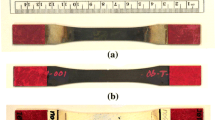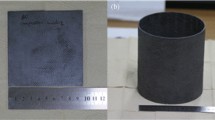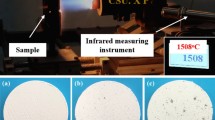Abstract
Fatigue behavior of Sylramic-iBN/BN/CVI SiC CMC was investigated under tension–tension fatigue using a test facility which simulated simultaneously both loading and combustion conditions of hot-section components of gas turbine engines. Combustion environment was created using a high-velocity oxygen fuel gun to impinge combustion flame on one side of specimen subjected to fatigue to simulate the real situation. The flame-impinged surface of specimen was heated to average temperature of 1250, 1350, or 1480 °C. Ultimate tensile strength of CMC was about 270 MPa at 1480 °C under combustion environment. Fatigue life diagram was established at stress ratio of 0.1 and frequency of 1 Hz. The CMC survived up to 25 h at 46 and 33 % of ultimate tensile strength under combustion at 1250 and 1350 °C, respectively. However, it could not survive 25 h at 1480 °C under combustion fatigue environment even with no stress on the specimen due to degradation/erosion of the material. Microscopic analysis of fracture surface showed oxidation of BN interface, which was more on flame side than other side. Fracture surfaces showed oxide formation over matrix, fibers, and/or fiber/matrix interphase causing embrittlement and thereafter failure of CMC.
















Similar content being viewed by others
References
Schmidt S, Beyer S, Knabe H, Immich H, Meistring R, Gessler A (2004) Advanced ceramic matrix composite materials for current and future propulsion system applications. Acta Astronaut 55:409–420
DiCarlo JA, Roode MV (2006) Ceramic composite development for gas turbine hot section components. In: Proceedings of the ASME Turbo Expo: Power for Land, Sea and Air, vol. 2, pp. 221–231
Haynes JA, Lance MJ, Cooley KM, Ferber MK, Lowden RA, Stinton DP (2000) CVD multiple coating in high-temperature, high-pressure air-H2O. J Am Ceram Soc 83–3:657–659
Opila EJ, Hann RE (1997) Paralinear oxidation of SiC in water vapor. J Am Ceram Soc 80–1:197–205
Opila EJ (1994) Oxidation kinetics of chemically vapor deposited silicon carbide in wet oxygen. J Am Ceram Soc 77–3:730–736
Opila EJ (1999) Variation of oxidation rate of silicon carbide with water-vapor pressure. J Am Ceram Soc 82–31:625–636
Jacobson NS (1993) Corrosion of silicon-based ceramics in combustion environments. J Am Ceram Soc 76–1:3–28
Tomas-Ogbuji L (1998) A pervasive model of oxidation degradation in a SiC-SiC composite. J Am Ceram Soc 82–11:2777–2784
More KL, Tortorelli PF, Lin HT, Lara-Curzio E, Lowden RA (1998) Degradation mechanisms of BN interfaces in SiC/SiC composites in oxygen- and water containing environments. Electrochem Soc Proc 98–99:382–395
Cofer GC, Economy J (1995) Oxidative and hydrolytic stability of boron nitride—a new approach to improving the oxidation resistance of carbonaceous structures. Carbon 33–4:389–395
Matsuda T (1989) Stability to moisture for chemically vapour-deposited boron nitride. J Mater Sci 24:2353–2357
Morscher GN, Bryant D, Tressler RE (1997) Environmental durability of different BN interphases (for SiC/SiC) in H2O-containing atmospheres at intermediate temperatures. Ceram Eng Sci Proc 18–3:525–533
Tomas-Ogbuji L (1998) Degradation of SiC/BN/SiC composite in the burner rig. Ceram Eng Sci Proc 19–4:257–264
Jacobson N, Farmer S, Moore A, Sayir H (1999) High-temperature oxidation of boron nitride: I. Monolitic boron nitride. J Am Ceram Soc 82–2:393–398
Jacobson NS, Morscher GN, Bryant DR, Tressler RE (1999) High-temperature oxidation of boron nitride: II. Boron nitride layers in composites. J Am Ceram Soc 82–6:1473–1482
LaRochelle KJ, Mall S (2003) Temperature and moisture effects upon stress rupture life of Syl-iBN/BN/SiC composites. Ceram Eng Sci Proc 24–4:459–464
Mall S, LaRochelle KJ (2006) Fatigue and stress-rupture behaviors of SiC/SiC composite under humid environment at elevated temperature. Compos Sci Technol 66:2925–2934
Mall S (2005) Effects of moisture on fatigue behavior of SiC/SiC composite at elevated temperature. Mater Sci Eng A 412:165–170
Ogbuji LUJT, Yun HM, DiCarlo J (2002) Effect of adventitious carbon on the environmental degradation of SiC/BN/SiC composites. NASA/TM 2002-211494
Ogbuji LUJT (2000) Degradation of a SiC/SiC composite in the burner rig: investigation by fractography. Mater High Temp 17–2:369–372
Richardson GY, Lei CS, Singh RN (2004) Mechanical properties of ceramic matrix composites exposed to rig tests. Ceram Eng Sci Proc 25–4:153–159
Kim TT, Mall S, Zawada LP (2009) Fatigue characterization of a melt-infiltrated woven Hi-NiC-S/BN/SiC ceramic matrix composite (CMC) using a unique combustion test facility. Ceram Trans 179:103–116
Kim TT, Mall S, Zawada LP, Jefferson G (2010) Simultaneous fatigue and combustion exposure of a SiC/SiC ceramic matrix composite. J Compos Mater 44–25:2991–3016
Kim TT, Mall S, Zawada LP (2011) Fatigue behavior of Hi-Nic-S/BN/SiC ceramic matrix composites in a combustion environment. Int J Appl Ceram Technol 8–2:261–272
Mall S, Nye AR, Jefferson G (2012) Tension-tension fatigue behavior of Nextel™720/Alumina under combustion environment. Int J Appl Ceram Technol 9–1:159–171
Robinson RC, Smialek JL (1999) SiC recession caused by SiO2 scale volatility under combustion conditions: I. Experimental results and empirical model. J Am Ceram Soc 82–7:1817–1825
Opila EJ, Smialek JL, Robinson RC, Fox DS, Jacobson NS (1999) SiC recession caused by SiO2 scale volatility under combustion conditions: II. Thermodynamics and gaseous-diffusion model. J Am Ceram Soc 82–7:1826–1834
Author information
Authors and Affiliations
Corresponding author
Additional information
The views expressed in this article are those of the authors and do not reflect the official policy or position of the United State Air Force, Department of Defense, or the U.S. Government.
Rights and permissions
About this article
Cite this article
Bertrand, D.J., Sabelkin, V., Zawada, L. et al. Fatigue behavior of sylramic-iBN/BN/CVI SiC ceramic matrix composite in combustion environment. J Mater Sci 50, 7437–7447 (2015). https://doi.org/10.1007/s10853-015-9302-8
Received:
Accepted:
Published:
Issue Date:
DOI: https://doi.org/10.1007/s10853-015-9302-8




